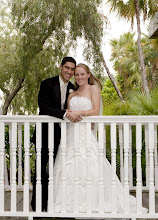Wow, I can't believe it's been over a month since
my last stringwork post! Phew! So without further ado, here we go!
If you need a quick review, help on icing consistency, etc., check out these other stringwork tutorials:
Basic StringworkStringwork with a BridgeBridgelss StringworkI'm using the same cake dummy from the last few tutorials, so just ignore the extra stringwork designs you see in the photos.
Step 1: Initial Drop Strings
Begin by piping basic drop strings along the top edge of your cake. I'll just be doing 2 for this tutorial, but you can do them all the way around your cake if you want! Keep these drop strings relatively short in width and length - it'll be easier for you in the long run.


 Step 2: Attach Sugar Pearls
Step 2: Attach Sugar PearlsPlace a small dot of royal icing at the intersection points of the drop strings. Press a sugar pearl on each royal icing dot. Let these dry completely before continuing. (Sorry, no photos for this step, but you can see the pearls in the next step.)
Step 3: Flip the Cake Upside-Down
Yup, you heard me. Upside-down. Place the flipped cake on a riser of some sort - another Styrofoam cake dummy works really well. Of course if you're working on a Styrofoam dummy, just grab the sucker and flip it over. If it's real cake, you'll need to use more precaution.
To flip a real cake: Cover the cake in fondant, and allow it to harden (overnight is best). Place a piece of cardboard the same size as your cake on top of the cake. For example, if your cake is an 8-inch round, place an 8-inch round cardboard piece on top of the cake. Then carefully flip the cake over so that it's now resting on the 8-inch round cardboard piece.
Step 4: Pipe Inverted Strings
Just like you would on the side of the cake, pipe drop strings from pearl to pearl. You'll quickly realize that these strings break easily. That's why it's important that your original strings in Step 1 were short.

If you're having an overwhelming amount of string breakage, check your icing consistency. It could be too wet (is it really shiny?) or too dry (is it cracking?). Alternatively, your strings may also be too long, and you simply can't defy the laws of gravity.

However, don't be too disappointed with some breakage - that's normal! In fact, in some of these pictures, you'll see my string boneyard (all the broken strings that fall to the cake board).
Once you get the strings to stay in place, let them dry a few minutes before continuing. We'll be flipping the cake back over in the next step so your strings need to be dry enough to hold their shape when the cake is moved.
Step 5: Pipe Your Second Layer of Strings
Flip the cake over again so that its now in its original position. Pipe another set of drop strings from pearl to pearl.
Step 6: Add Pearls and Continue The String Layers
Just like before, "glue" sugar pearls at the string intersection points. Continue to flip and unflip the cake, adding more strings & pearls, until you have the desired dimensions & depth.
Today, I'll be stopping at 2 layers, but you get the point. Of course, the further you go out, the more fragile the set-up will be - but also the more impressive!


The key to creating gorgeous Oriental stringwork is to keep the strings within each layer the same shape and size. However, the shape and size may gradually increase or decrease as you add layers. For example, I started with larger strings and then got smaller as the strings moved away from the side of the cake.

That's an impressive cake profile, isn't it?!
Now, as a bonus, I'll share some more creative Oriental stringwork. I always say this, but think outside the box! Everyone does stringwork like the example shown above! But who said the strings have to be perfect half-circles or sit at the top edge of the cake?

Here, I started with some basic strings up against the side of the cake. Then I attached pearls at the intersection points.

I flipped the cake and piped more basic stringwork against the side of the cake. Note: this step would have been easier if I'd attached the pearls AFTER I'd piped the strings, but I don't always do things the easy way...
Then, after a series of flipping, unflipping, piping, and pearl gluing, I arrived at this finished product:


Have you ever seen THAT in a book? (Seriously, if you have, I'd love to see the book!)
So I can now say that I've shared with you everything I know, to date, about stringwork! People pay lots of money to take stringwork classes, and now you don't have to! If you make any stringwork cakes/sugar art pieces using my tutorials, please send me the photos at phdserts[at]gmail[dot]com. I would LOVE to see the photos and post them here, with permission.
What's next? I'm organizing for a very informative article about how to prepare for and win a cake decorating competition! Oh yea, more insider secrets! And I hope you'll use them at the
Florida I.C.E.D. Cake Competition. Yup, that was a shameless plug. *wink*
































































